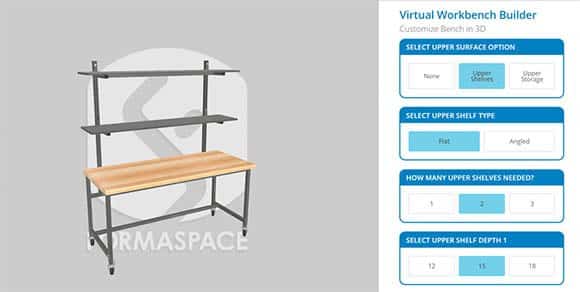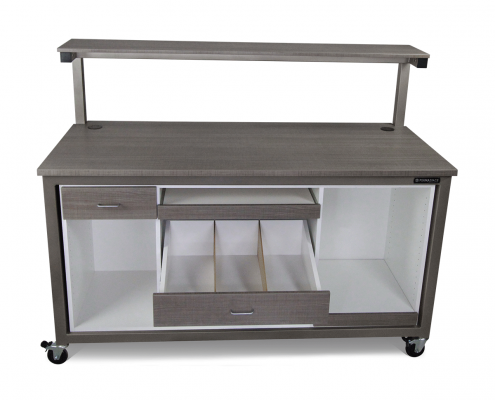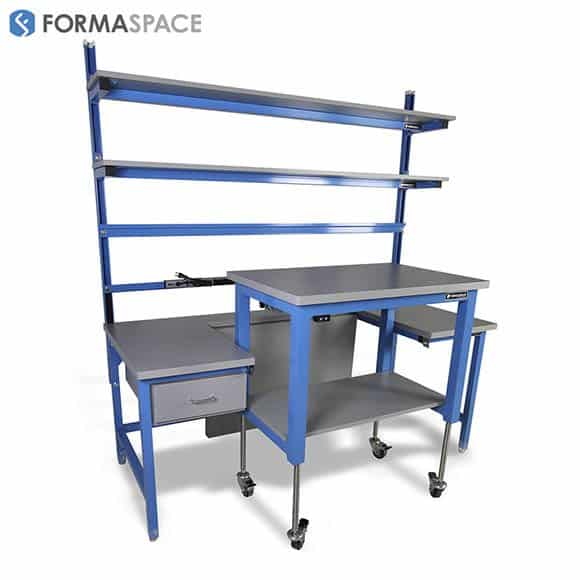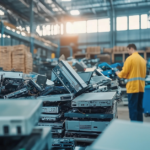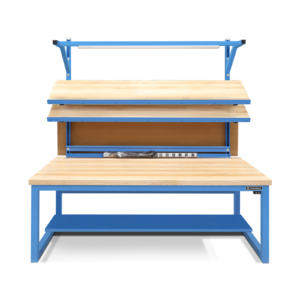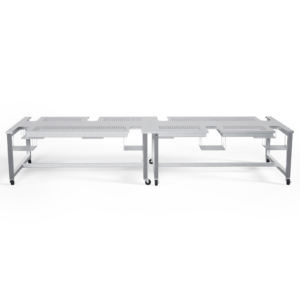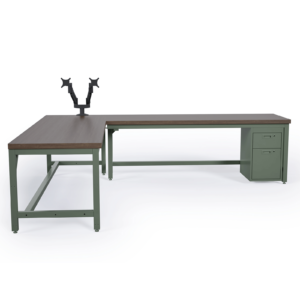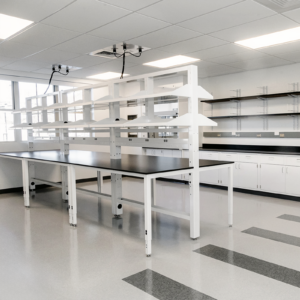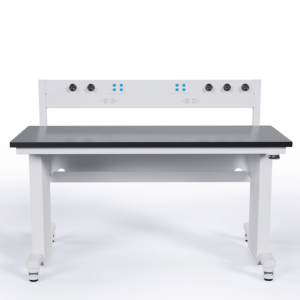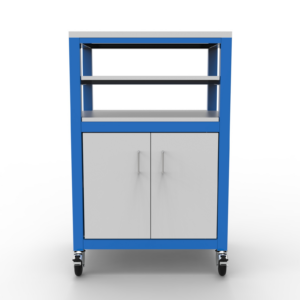Thanks to a growing economy, 2018 is proving to be a year of great opportunities for American manufacturers as they invest to continue improving factory production times and product quality. As we enter the second quarter of 2018, we take a look at the top 8 manufacturing trends in 2018.
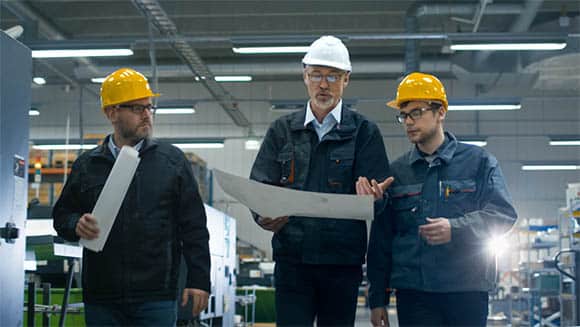
Top 8 Manufacturing Trends 2018: Industry Outlook
As we speak with our Formaspace customers across the nation, we’ve been getting first-hand confirmation that the American economy is strong, and that 2018 is proving to be an exceptionally busy year for our manufacturing customers.
Given this upside, we wanted to know how manufacturers are taking advantage of the economic upturn.
What are the current trends at work to get closer to the customer, make production more efficient, and to improve quality?
To answer these questions, we’ve identified what we feel are the top manufacturing trends in 2018:
1. Manufacturers are Responding to Heightened Customer Expectations Caused by the Amazon Effect
For many consumer product manufacturers, all eyes are on online sales giant Amazon as it continues to increase its sales penetration across a widening number of product and service categories.
Indeed, Amazon’s market presence is having an outsized effect, logically dubbed the Amazon Effect, that’s changing consumer behavior. For example, an increasing number of customers are turning to Amazon’s website as their first stop when making product comparisons and purchasing decisions. And the rapid delivery offered by Amazon is changing customer expectations as well; many Amazon orders can be delivered to the customer in 48 hours or less, not several days or weeks.
How are manufacturers responding to these changing market conditions?
Rather than relying solely on a traditional indirect dealer and distribution model, more and more consumer-brand manufacturers are pursuing an ‘omnichannel’ strategy that adds a Direct-to-Consumer (DTC) retail component.
The footwear giant Nike is a good example; as part of its “Consumer Direct Offense” initiative, it will open local retail outlets in 12 cities in order to provide “2X Innovation, 2X Speed, and 2X Direct connections with consumers.”
2. Manufacturers are Accelerating the Industry 4.0 Revolution in Smart Manufacturing
Like other innovative manufacturers, Nike is redesigning its product development and manufacturing process to reduce development and delivery times. (In the press release above, Nike says it wants to cut these times in half.)
How can it be done?
More and more manufacturers are actively engaged in a fundamental re-think of their product development and manufacturing process — moving toward a set of smart manufacturing strategies collectively known as the Industry 4.0 innovation revolution.
What constitutes Smart Manufacturing and Industry 4.0? It’s not just one thing, it’s more of a combined set of breakthroughs brought about by advances in digital technology.
Robots, Cloud Computing, and the Internet of Things are part of it. (We’ll address these trends in the following sections below.) But first, one of the benefits brought about Industry 4.0 manufacturing techniques is getting closer to the customer to get their crucial input when making product design decisions.
How does this work in practice?
Advanced CAD/CAM design software connected with advanced visualization technology (from game simulations, Virtual Reality goggles) and Augmented reality systems are not only dramatically reducing product development times, they allow consumers to participate in the process to either ‘crowdsource’ or ‘co-create’ customized products direct from the manufacturer.
Formaspace’s advanced Virtual Workbench Builder is a good example of this. Using this tool, our customers can “build” custom workbenches and see the results in real-time, using game-based, photorealistic computer rendering technology. Once the customer makes a decision, the completed order is sent immediately to our factory headquarters in Austin, Texas; this speeds up the custom furniture ordering and manufacturing processes significantly.
3. Manufacturers are Investing in Robotics to Handle Repetitive Tasks
When people first hear about the Industry 4.0 revolution in manufacturing, they often first think about robots.
It’s true. Robotics is an increasing part of the solution, especially for the least attractive (to humans that is) repetitive tasks on the assembly line and for picking/shipping tasks in distribution centers.
In our article “Should Robots Replace Humans in Your Industrial Facility?” we uncovered some of the key pros and cons of making an investment in robotics.
We can add that today’s extremely low unemployment rate and recent corporate tax changes may tip the scales toward making greater capital investments in robotics.
However, as Tesla Motors has recently discovered, bringing a large, robotics-centric production line on-line all at once is fraught with risk. A gradual transition that offloads repetitive tasks and frees up personnel for more interesting and higher value work may be the right approach.
4. Manufacturers are Leveraging the Benefits of Enhanced IoT Data Collection and Analysis to Increase Quality and Speed up Production
American manufacturing quality today is light-years ahead of where we found ourselves a generation or two ago.
Yet, despite these gains, ongoing Industry 4.0 advances in automated sensors and remote data collection will provide even more opportunities to increase quality while speeding up production.
What kind of sensors are we talking about? In general-interest media publications, the so-called “Internet of Things” (IoT) devices have garnered a lot of attention, often illustrated with consumer examples, such as the refrigerator that orders milk from the store when quantities are low.
But remote sensors built into products are having a profound positive effect on manufacturers. They allow a variety of products in the field to “phone home” to the manufacturer’s cloud-based data systems, providing invaluable feedback on how much use they are seeing, malfunctions, and service history, etc.
As more and more data is collected, manufacturers are also stepping up their game to “do something” with big-data sets. Increasingly, they are turning to data-mining software solutions powered by artificial intelligence and machine learning algorithms. Another analysis technique gaining in popularity among manufacturers is process mining, which uses collected data to reverse engineer and tabulate actual processes happening on the factory floor and in the field.
5. Manufacturers Need to Mitigate Risks to Supply Chains Associated with Turbulence in International Trade Agreements
Are there clouds on the horizon in 2018?
Yes, there are a few.
One is the exceptionally low unemployment rate, which is, ironically, exacerbating the long-standing problem of attracting quality workers in the manufacturing sector, especially those with STEM qualifications. (We recently wrote about cultural changes you can make at your manufacturing facility to make it more attractive for new recruits.)
The second cloud on the horizon is the potential for changed trading relationships around the world, which could impact finely-tuned, long supply chains across the globe.
Among the affected agreements, two appear to be off the table for now: the proposed TTIP free trade agreement between the U.S. and the E.U., as well as the Trans-Pacific Partnership (TPP) among twelve Pacific countries, including the U.S., Japan, Canada, and Australia.
We may also see further changes to the KORUS free trade agreement between the U.S. and South Korea as well as the big kahuna, NAFTA, which is currently being renegotiated between US, Canadian, and Mexican trade representatives.
NAFTA is of great interest to American automotive manufacturers, which will need time to make production adjustments should the agreement change.
Adding to the uncertainty is a potential global trade war due to the threat of tariffs on imported steel as well as the consequences of BREXIT, the exit of the UK from the European Union. Among the chief worries is the UK falling off a trade “cliff edge” with its major trading partner (the EU) should it fail to ratify a transitional agreement by March 29, 2019.
Finally, energy costs are another concern on the horizon, particularly for energy-intensive manufacturers or those who use a lot of oil-based materials, such as plastics. Some are predicting $100/bbl oil prices within a year.
How should American manufacturers prepare?
Another round of energy saving is on the way (see trend 8 below). Buying American materials and products is another good strategy.
Here at Formaspace, all our furniture is produced at our Austin, Texas factory headquarters. We also only use American-made steel in our products.
6. Manufacturers Need to Steer Clear of Cyber Attacks Affecting Their Production Lines and Supply Chains
If you’ve been led to believe that computer hacking and ransom-ware extortion schemes happen to business organizations in other sectors, such as retail chains or healthcare organizations, think again.
According to recent news reports, Cyber Criminals are increasingly setting their sights on manufacturing facilities. Aware that in today’s just-in-time manufacturing environment, a slowdown of even a few hours production time can cost a manufacturer thousands or even hundreds of thousands of dollars, thieves are now actively targeting vulnerable factory production lines. Once they find an opening in the company’s IT security defenses — often by breaking into weakly protected devices connected to the Internet (such as barcode scanners) — they can lock down and encrypt computer data systems in the hope of extracting a hefty ransom payment in exchange for unlocking the company’s data.
Computer scientists are looking for ways to keep one step ahead of cybercriminals. One potential solution is the technology behind virtual currencies, known as blockchain algorithms. These algorithms use an anonymous yet accountable method to maintain a history of digital signature to each change made in a dataset, which, in turn, could make shared data in supply chain ledgers more accountable and less vulnerable to fraud.
You can learn more about this and other efforts to reduce the risk of attacks by cybercriminals in our upcoming article on keeping your digital infrastructure safe from attack. Look for it soon.
7. Manufacturers Investing in New Technologies; Additive Manufacturing Continues to Grow
Here at Formaspace, we’ve experienced a notable uptick in orders for extra heavy-duty furniture that’s often destined for new installations of additive manufacturing equipment.
If the term additive manufacturing is new, think 3D printers, which are a type of additive manufacturing technology. Unlike traditional machining process, such as milling, routing, and turning, which remove excess raw materials to produce finished parts, additive manufacturing builds up parts layer-by-layer.
In the early days of 3D Printing, the technology was sufficiently advanced for quick prototyping, but the lack of available material stock choices (initially limited to certain types of plastic), the relatively slow production speed, and the rough, stepped surface finishes ruled out using 3D printers for general manufacturing production.
As the technology matured, 3D printing began to find a niche in manufacturing ‘long tail’ inventory, e.g. items that are rarely called for. In some cases, manufacturers reduced their long tail inventory stock to zero, in favor of printing out a new part when needed.
Times have changed. Additive manufacturing processes are now faster and capable of not only printing different materials (such as metals) but also now able to mix different materials and material properties within a single “print job.”
Today, you’ll find 3D printing technology used to print SpaceX Super Draco Engines (FYI SpaceX is a Formaspace customer).
SpaceX Tests 3D-Printed SuperDraco Engines
8. Green Manufacturing is Efficient Manufacturing
Minimizing and reusing waste has always been our mantra here at Formaspace. From using reclaimed wood for natural live-edge tables to using excess wood from the production floor to build shipping crates, to collecting over-spray to make our Eco-Gray powder coating materials, to building strong, modular furniture that can be used for generations (and potentially help you earn LEED credits), we do our best to pursue a green manufacturing path here at Formaspace.
Industrial Bench Plus customized with Woodgrain HPL – powder coated in satin nickel with woodgrain laminate top.
We’re part of an emerging trend.
European-American transplants, such as the BMW car production facility in Spartanburg, SC (which happens to be BMW’s largest factory worldwide as well as the leading U.S. car exporting factory) have also introduced many sustainable business practices to the US-based on European Union directives. These EU directives address a variety of important sustainable “green” business practices, ranging from reducing product packaging waste to requiring manufacturers to plan for the life-cycle impact of products, including how their constituent parts will be recycled and reused when they have reached the end of life.
As we mentioned earlier, the specter of $100/bbl oil will have ripple effects throughout many manufacturing sectors. We expect that most manufacturing companies will double down on their efforts in 2018 to make their process more energy efficient.
Formaspace is Your Manufacturing Partner
Looking for ways to make your manufacturing facility more efficient and productive?
Turn to Formaspace.
Here at Formaspace, we not only manufacture heavy-duty furniture for factories and distribution centers (including our line of fully height-adjustable workbenches and tables), we also provide insightful consulting services for our manufacturing customers.
Consider engaging Formaspace to come to your facility and perform a Rapid Plan Assessment. It’s not a long, drawn-out process; we get right down to business and provide you with an actionable report that’s based on our years of experience improving the layout and operational efficiency of factories and manufacturing plants around the US — and around the world.
When it comes time to grow or modify your manufacturing lines, go with the proven leader. Formaspace is the industrial furniture supplier for top Fortune 100 and 500 companies and more, including Apple, Boeing, Dell, Ford Motor Company, SpaceX, Toyota, and more.
If you can imagine it, we can build it.
Take the next step. Contact your friendly Formaspace Design Consultant today.


